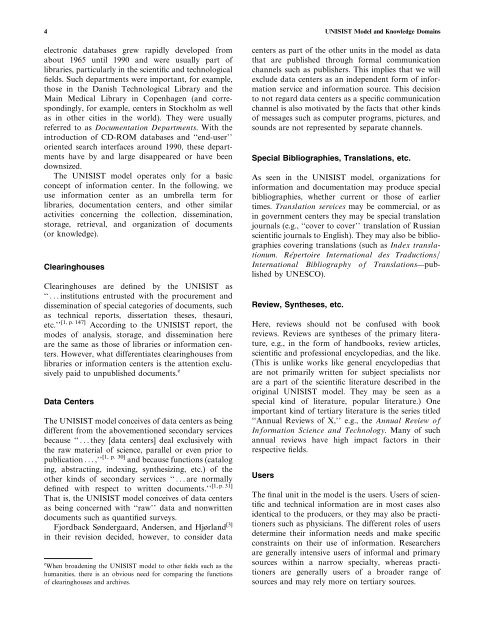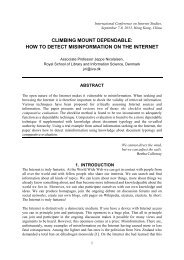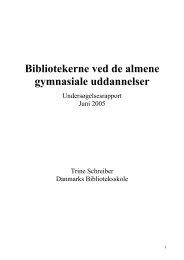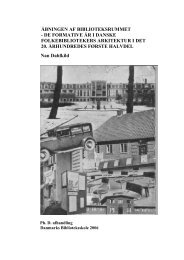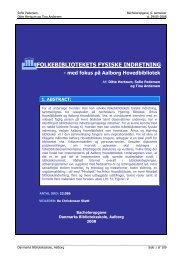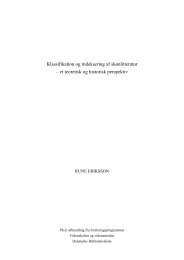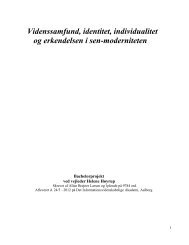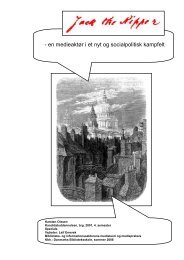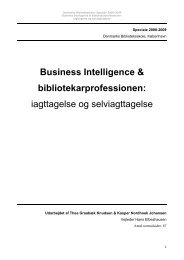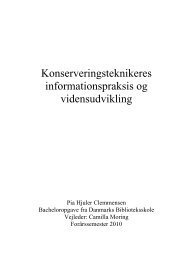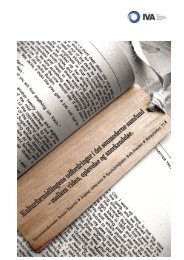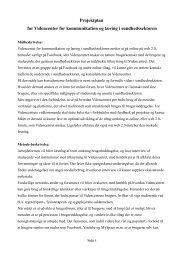UNISIST Model and Knowledge Domains
UNISIST Model and Knowledge Domains
UNISIST Model and Knowledge Domains
You also want an ePaper? Increase the reach of your titles
YUMPU automatically turns print PDFs into web optimized ePapers that Google loves.
4 <strong>UNISIST</strong> <strong>Model</strong> <strong>and</strong> <strong>Knowledge</strong> <strong>Domains</strong><br />
electronic databases grew rapidly developed from<br />
about 1965 until 1990 <strong>and</strong> were usually part of<br />
libraries, particularly in the scientific <strong>and</strong> technological<br />
fields. Such departments were important, for example,<br />
those in the Danish Technological Library <strong>and</strong> the<br />
Main Medical Library in Copenhagen (<strong>and</strong> correspondingly,<br />
for example, centers in Stockholm as well<br />
as in other cities in the world). They were usually<br />
referred to as Documentation Departments. With the<br />
introduction of CD-ROM databases <strong>and</strong> ‘‘end-user’’<br />
oriented search interfaces around 1990, these departments<br />
have by <strong>and</strong> large disappeared or have been<br />
downsized.<br />
The <strong>UNISIST</strong> model operates only for a basic<br />
concept of information center. In the following, we<br />
use information center as an umbrella term for<br />
libraries, documentation centers, <strong>and</strong> other similar<br />
activities concerning the collection, dissemination,<br />
storage, retrieval, <strong>and</strong> organization of documents<br />
(or knowledge).<br />
Clearinghouses<br />
Clearinghouses are defined by the <strong>UNISIST</strong> as<br />
‘‘ ...institutions entrusted with the procurement <strong>and</strong><br />
dissemination of special categories of documents, such<br />
as technical reports, dissertation theses, thesauri,<br />
etc.’’ [1, p. 147] According to the <strong>UNISIST</strong> report, the<br />
modes of analysis, storage, <strong>and</strong> dissemination here<br />
are the same as those of libraries or information centers.<br />
However, what differentiates clearinghouses from<br />
libraries or information centers is the attention exclusively<br />
paid to unpublished documents. e<br />
Data Centers<br />
The <strong>UNISIST</strong> model conceives of data centers as being<br />
different from the abovementioned secondary services<br />
because ‘‘ ...they [data centers] deal exclusively with<br />
the raw material of science, parallel or even prior to<br />
publication ...,’’ [1, p. 30] <strong>and</strong> because functions (catalog<br />
ing, abstracting, indexing, synthesizing, etc.) of the<br />
other kinds of secondary services ‘‘ ...are normally<br />
defined with respect to written documents.’’<br />
[1, p. 31]<br />
That is, the <strong>UNISIST</strong> model conceives of data centers<br />
as being concerned with ‘‘raw’’ data <strong>and</strong> nonwritten<br />
documents such as quantified surveys.<br />
Fjordback Søndergaard, Andersen, <strong>and</strong> Hjørl<strong>and</strong> [3]<br />
in their revision decided, however, to consider data<br />
e When broadening the <strong>UNISIST</strong> model to other fields such as the<br />
humanities, there is an obvious need for comparing the functions<br />
of clearinghouses <strong>and</strong> archives.<br />
centers as part of the other units in the model as data<br />
that are published through formal communication<br />
channels such as publishers. This implies that we will<br />
exclude data centers as an independent form of information<br />
service <strong>and</strong> information source. This decision<br />
to not regard data centers as a specific communication<br />
channel is also motivated by the facts that other kinds<br />
of messages such as computer programs, pictures, <strong>and</strong><br />
sounds are not represented by separate channels.<br />
Special Bibliographies, Translations, etc.<br />
As seen in the <strong>UNISIST</strong> model, organizations for<br />
information <strong>and</strong> documentation may produce special<br />
bibliographies, whether current or those of earlier<br />
times. Translation services may be commercial, or as<br />
in government centers they may be special translation<br />
journals (e.g., ‘‘cover to cover’’ translation of Russian<br />
scientific journals to English). They may also be bibliographies<br />
covering translations (such as Index translationum.<br />
Répertoire International des Traductions=<br />
International Bibliography of Translations—published<br />
by UNESCO).<br />
Review, Syntheses, etc.<br />
Here, reviews should not be confused with book<br />
reviews. Reviews are syntheses of the primary literature,<br />
e.g., in the form of h<strong>and</strong>books, review articles,<br />
scientific <strong>and</strong> professional encyclopedias, <strong>and</strong> the like.<br />
(This is unlike works like general encyclopedias that<br />
are not primarily written for subject specialists nor<br />
are a part of the scientific literature described in the<br />
original <strong>UNISIST</strong> model. They may be seen as a<br />
special kind of literature, popular literature.) One<br />
important kind of tertiary literature is the series titled<br />
‘‘Annual Reviews of X,’’ e.g., the Annual Review of<br />
Information Science <strong>and</strong> Technology. Many of such<br />
annual reviews have high impact factors in their<br />
respective fields.<br />
Users<br />
The final unit in the model is the users. Users of scientific<br />
<strong>and</strong> technical information are in most cases also<br />
identical to the producers, or they may also be practitioners<br />
such as physicians. The different roles of users<br />
determine their information needs <strong>and</strong> make specific<br />
constraints on their use of information. Researchers<br />
are generally intensive users of informal <strong>and</strong> primary<br />
sources within a narrow specialty, whereas practitioners<br />
are generally users of a broader range of<br />
sources <strong>and</strong> may rely more on tertiary sources.


